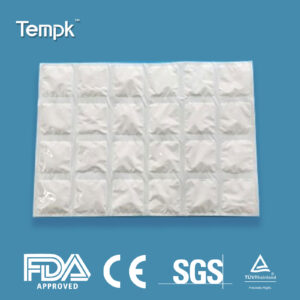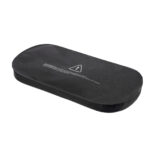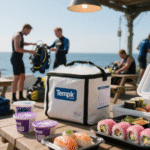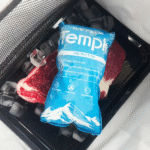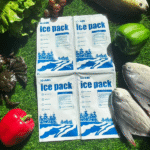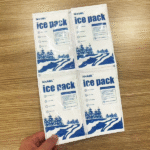Which 24-Cell Dry Ice Pack Fits Your Container Best?
Choosing the right 24-cell dry ice pack can make or break your shipment’s success. Within the first few minutes of reading, you’ll know exactly how to size, pack, and handle dry ice sheets—no guesswork. A single 24-cell sheet typically cools 5–8 L of container space for 24 hours, but proper planning can double that duration while reducing waste and ensuring safety.
-
Identify the best dry ice pack size and number of 24-cell sheets for any container.
-
Estimate dry ice weight (5–10 lb/day) for frozen lanes.
-
Follow safe packing and venting practices.
-
Learn hybrid cooling strategies for cost efficiency.
-
Apply 2025 trends in smart packaging and eco-design.
How many 24-cell dry ice packs do you need?
Start with 1 sheet per 5–8 L of internal volume for ~24 hours of hold time. For a 20 L shipper, use three sheets; for 30 L, four sheets. Each sheet delivers roughly 8–12 hours of chilled performance—extend by wrapping around the payload or combining with solid CO₂.
| Container Volume (L) | Starting Sheets | Typical Hold (chilled) | What This Means for You |
|---|---|---|---|
| 5–10 | 1 | 8–24 h | Small mailers or compact boxes |
| 15–20 | 2–3 | 24–48 h | Most DTC food or pharma parcels |
| 25–30 | 3–4 | 36–60 h | Large payloads needing extra margin |
| 40+ | 4–6 | 48–72 h | Extended lanes or high ambient routes |
Quick rule: Add one sheet for every extra 24 hours of shipping or every +10 °C ambient increase.
Fast sizing formula (for SOPs)
Example:
A 20 L insulated box on a 36 h route in summer:
20 L ÷ 7 ≈ 3 sheets + 1 (hot weather) = 4 total.
How does insulation affect your dry ice pack count?
The better the insulation, the fewer packs you need. EPS foam maintains cold longest, while cardboard liners need extra help.
| Container Type | Insulation Rating | Recommended Dry Ice | Real-World Insight |
|---|---|---|---|
| EPS (Styrofoam) | Excellent | 5 lb / 24 h | Ideal for biopharma & frozen foods |
| Plastic Crate | Good | 6–7 lb / 24 h | Works for DTC food delivery |
| Cardboard + Liner | Moderate | 8–9 lb / 24 h | Add 1–2 sheets for warm lanes |
Tip: Pre-chill your box before packing. Cold walls keep sheets efficient.
How to calculate dry ice weight for frozen shipments
For frozen lanes (−20 °C or colder), use solid CO₂ dry ice measured by weight:
Formula:Dry Ice (lb) = Hold Days × 7.5 (lb/day) × (1 + 0.2 reserve)
Example: 2 days × 7.5 = 15 lb + 20% = 18 lb total.
| Hold Time | Tight EPS Shipper | Typical Cooler | Loose Cooler |
|---|---|---|---|
| 24 h | 5 lb | 7.5 lb | 10 lb |
| 48 h | 10 lb | 15 lb | 20 lb |
| 72 h | 15 lb | 22.5 lb | 30 lb |
Use the lower end for dense EPS foam and the higher end for thinner boxes or hot climates.
When to use 24-cell sheets vs. solid CO₂
| Use Case | Best Refrigerant | Why It Works | Watch Out For |
|---|---|---|---|
| 0–8 °C chilled goods | 24-cell dry ice pack | Flexible, non-hazmat, reusable | Shorter hold time |
| ≤ −20 °C frozen lanes | Solid CO₂ (dry ice) | Deep cold, long duration | Requires labeling & venting |
| 36–60 h mixed loads | Hybrid setup | Combine sheets + small CO₂ slab | Needs training & SOP |
Real-world case: A biotech shipper swapped block ice for 24-cell sheets in EPS boxes and cut spoilage 22% while reducing packing time 40%.
Safe packing SOP for 24-cell dry ice sheets
-
Hydrate fully in warm water until bubbles stop.
-
Freeze flat for 24–48 h at ≤ −18 °C.
-
Pre-chill both product and shipper.
-
Wrap & cap: line sides and top for 360° coverage.
-
Vent properly—never seal solid CO₂ airtight.
-
Wear gloves to avoid frost burns.
-
Label UN 1845 if any solid CO₂ is included.
Case study: A meal-kit brand reduced summer warm-arrival issues by one-third after adopting wrap-and-cap packing.
2025 trends in dry ice packaging
The cold chain industry is embracing smart, sustainable, and hybrid designs:
-
Reusable cut-to-fit sheets reduce waste and trim along seams.
-
Precision sublimation control improves CO₂ efficiency (3–8% loss/day).
-
Smart temperature sensors send alerts for temperature excursions.
-
Hybrid packouts mix sheets + CO₂ slabs for cost-balanced performance.
Market insight: Brands adopting seasonal validation logs have cut spoilage 30–60% while lowering material waste.
FAQs
Q1: Is a 24-cell dry ice pack the same as solid dry ice?
No. 24-cell packs are polymer sheets cooling near 0 °C; solid CO₂ reaches −78.5 °C.
Q2: How long does one 24-cell sheet last?
Around 8–12 hours per sheet; wrap with 2–4 sheets for 24–36 hours.
Q3: Can I fly with dry ice?
Yes—≤ 2.5 kg (5.5 lb) per passenger with venting and UN 1845 marking. Cargo follows IATA PI 954 for higher limits.
Q4: Can I reuse dry ice packs?
Hydrated polymer packs can be refrozen; solid CO₂ cannot—it sublimates to gas.
Q5: What’s the safe way to dispose of leftover dry ice?
Let it sublimate in a ventilated area—never seal or dump in sinks.
Summary & recommendations
-
Use one 24-cell sheet per 5–8 L of volume for 24 h chilled control.
-
Add 30–40% for longer or hotter shipments.
-
Use 5–10 lb/day of solid CO₂ for frozen lanes.
-
Always vent, label, and monitor temperature.
-
Validate every lane with a two-box PQ test.
Next step: Measure your container, apply the formula, and test one shipment. For precise results, request a free packout review from Tempk’s specialists.
About Tempk
Tempk engineers validated cold chain solutions—from flexible 24-cell dry ice sheets to hybrid CO₂ packouts. Our systems are tested for real-world lanes across food, pharma, and biotech logistics. We focus on performance, safety, and sustainability, helping clients reduce spoilage and cost while meeting all IATA PI 954 and UN 1845 requirements.
Talk to us for a lane-specific dry ice strategy or a print-ready SOP today.






